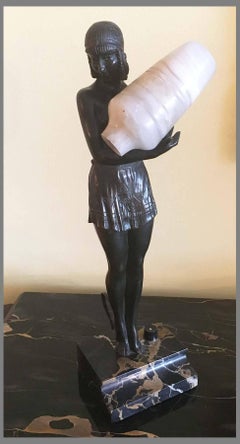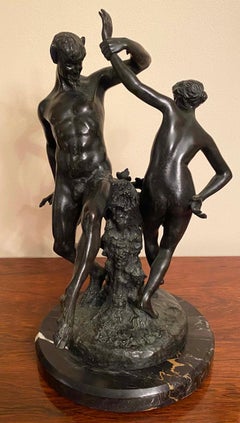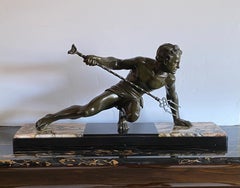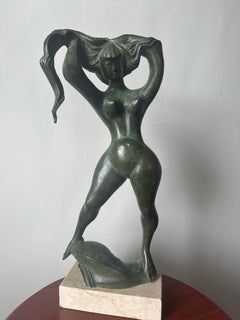Want more images or videos?
Request additional images or videos from the seller
1 of 5
Alexander DanielSeated Lady1990
1990
$950List Price
About the Item
About the Seller
5.0
Vetted Professional Seller
Every seller passes strict standards for authenticity and reliability
Established in 1972
1stDibs seller since 2011
409 sales on 1stDibs
Authenticity Guarantee
In the unlikely event there’s an issue with an item’s authenticity, contact us within 1 year for a full refund. DetailsMoney-Back Guarantee
If your item is not as described, is damaged in transit, or does not arrive, contact us within 7 days for a full refund. Details24-Hour Cancellation
You have a 24-hour grace period in which to reconsider your purchase, with no questions asked.Vetted Professional Sellers
Our world-class sellers must adhere to strict standards for service and quality, maintaining the integrity of our listings.Price-Match Guarantee
If you find that a seller listed the same item for a lower price elsewhere, we’ll match it.Trusted Global Delivery
Our best-in-class carrier network provides specialized shipping options worldwide, including custom delivery.You May Also Like
Javelin thrower / - Roman present -
By Franz Iffland
Located in Berlin, DE
Franz Iffland (1862 Tempelhof - 1935 Berlin), Javelin thrower, after 1910. Olive-black patinated bronze with cast plinth mounted on a white-veined black marble base (7 cm high). Tota...
Category
1910s Art Deco Nude Sculptures
Materials
Bronze
$2,393 Sale Price
20% Off
H 24.02 in W 10.24 in D 9.85 in
Giancarlo Impiglia, "The Appointment," acrylic on wood 1980 - Art Deco
By Giancarlo Impiglia
Located in Vicenza, VI
Acrylic on wood sculpture by Giancarlo Impiglia, titled "The Appointment," depicts a male figure, waiting for his appointment, with a hidden rose.
The sculpture, probably commission...
Category
1980s Art Deco Figurative Sculptures
Materials
Acrylic
$14,360
H 89.38 in W 40.56 in D 14.18 in
Fennec seated
Located in PARIS, FR
Fennec seated
by Edouard-Marcel SANDOZ (1881-1971)
Bronze with a nuanced brownish green patina
signed on the tail "Ed. M. Sandoz"
cast by "Susse Fres Edts Paris" (with the foundry m...
Category
1920s Art Deco Figurative Sculptures
Materials
Bronze
Neptune
By David Evans
Located in New York, NY
A super stylized and marvelously detailed work that epitomizes the playful and imaginative works of the 1920's. Garden and conservatory works were highly in vogue and demand at that...
Category
1920s Art Deco Figurative Sculptures
Materials
Bronze
Homage to Bela Bartok, Composer
By Albert W. Wein
Located in New York, NY
Béla Bartók, Hungarian composer and pianist, is considered to be one of the most important composers of the 20th century. Conceived in 1947 while Wein was in Rome after having been a...
Category
1940s Art Deco Figurative Sculptures
Materials
Bronze
$24,000
H 18 in W 6 in D 7.5 in
Europa & Zeus
By Bruno Zach
Located in Wien, Wien
Europe & Zeus (divine love)
Europa the daughter of the Phoenician king of Tyre, Agenor and Zeus in love in the shape of the bull.
Bronze, on onyx pedestal
Signed: Bruno Zach
Category
1920s Art Deco Figurative Sculptures
Materials
Bronze
Keith Murray Pottery designed for Wedgwood in the 1930's
Located in Brookville, NY
Keith Murray Pottery 6" matte green vessel. Excellent condition, normal wear on the bottom. We also have a larger collection of Keith Murray pottery in large Moonstone and Bombe, celadon polished glaze bowls and many others. Please contact for further details and photographs. Keith Murray was both an architect and industrial designer, considered one of the most famous industrial designers for art deco ceramics.
This green piece photographed, has a matching one in yellow. Each are 950.00 or $1700. for the pair. We have an extensive collection of his pieces, many not illustrated here. Please inquire for further photographs.
All from Keith Murray designed for Wedgwood in the 1930' and illustrated in the book "Wedgwood Ceramics...
Category
1930s Art Deco Still-life Sculptures
Materials
Clay
Gilbert Ledward - 1930s Watercolour Design for a Decorative Sculptural Frieze
Located in London, GB
GILBERT LEDWARD, RA, PRBS
(1888-1960)
Tennis, Golf, Shooting, Ice-Skating, Dreaming – Proposed Design for Decorative Frieze in the Italian Drawing Room at Eltham Palace, commissioned by Stephen Courtauld
Signed and dated July 9th 1933
Watercolour and pencil
12.5 by 49.5 cm., 5 by 19 ½ in.
(frame size 36 by 67 cm., 14 ¼ by 26 ¼ in.)
Exhibited:
The artist’s daughter;
London, The Fine Art Society, A Centenary Tribute, Feb 1988, no. 43.
Gilbert Ledward was born in London. He was educated at St Mark’s College, Chelsea. In 1905 he entered the Royal College of Art to study sculpture under Edouard Lanteri and in 1910 he entered the Royal Academy Schools. In 1913 he won the Prix de Rome for sculpture, the Royal Academy’s travelling award and gold medal, which allowed him to travel in Italy until the outbreak of the Wold War I. During the war he served as a lieutenant in the Royal Garrison Artillery and was appointed as an official war artist in 1918.
Following the war he was largely occupied as a sculptor of war memorials including the Guards Division memorial in St James’s Park and the Household Division’s memorial in Horse Guards Parade. In 1934, supported by Eric Gill and Edwin Lutyens, he established a company called Sculptured Memorials and Headstones, which promoted better design of memorials in English churchyards. His war memorials after World War II include one in Westminster Abbey to the Submarine Service, Commandos and Airborne Forces.
Ledward was Professor of Sculpture at the Royal College of Art (1927-1929) and in 1937 was elected at Royal Academician. He became President of the Royal Society of British Sculptors and a trustee of the Royal Academy.
The present work is a design for an intended decorative frieze for the Italian Drawing Room of Eltham Palace. In 1935 the remains of the medieval royal palace of Eltham was rescued from decay by Stephen and Virginia Courtald who built an ultra modern Art Deco house to adjoin the existing Great Hall. They employed the architects John Seeley and Paul Edward Paget and the fashionable Mayfair interior designer the Marchese Peter Malacrida to design the strikingly glamorous 1930s interiors of the new house. The dramatic entrance hall was created by the Swedish designer Rolf Engstromer...
Category
1930s Art Deco Figurative Sculptures
Materials
Watercolor
$2,746
H 12.5 in W 49.5 in
Richard Garbe - Helios - Early 20th Century British patinated plaster sculpture
By Richard Garbe
Located in London, GB
RICHARD LOUIS GARBE, RA
(1876-1957)
Helios
Signed and dated 1929
Plaster with patinated surface
86 cm., 33 ¾ in. high
Garbe was born in Dalston, London, the son of Gustave Garbe,...
Category
Early 20th Century Art Deco Nude Sculptures
Materials
Plaster
$7,552
H 33.86 in W 17.33 in
The Falconer, Art Deco British Plaster Sculpture by Richard Garbe RA
By Richard Garbe
Located in London, GB
RICHARD GARBE, RA
(1876-1957)
The Falconer
Signed and dated on the reverse: Richard Garbe, ARA / 1932
Patinated plaster
49.5 cm., 19 ½ in. high
Proven...
Category
1930s Art Deco Figurative Sculptures
Materials
Plaster
$5,492
H 19.49 in W 9.45 in D 5.12 in
More From This Seller
View AllWater Carrier
By Pierre Le Faguays
Located in Los Angeles, CA
PIERRE LE FAGUAYS
"WATER CARRIER"
BRONZE AND ALABASTER, SIGNED
ELECTRIFIED
FRANCE, C.1925
15.5 INCHES
A French sculptor of lithe female f...
Category
1920s Art Deco Figurative Sculptures
Materials
Bronze
Bacchanal
Located in Los Angeles, CA
Charles Edouard Richefeu (1868-1945)
A stunning dated 1926.
A faun and nude woman dancing.
Signed RICHEFEU in the bronze. Foundry mark stamp "R. COTTIN & FILS Paris Bronze".
Definitely inspired by Diagilev Russian Ballet and Nijinsky dancer on Claude Debussy...
Category
1820s Art Deco Figurative Sculptures
Materials
Bronze
$2,368 Sale Price
20% Off
The Fisherman
By Ugo Cipriani
Located in Los Angeles, CA
An impressive French Art Deco sculpture of a semi nude male holding a trident.
Cast in patinated French spelter and sits on a marble base.
We believe Bezin may be a pseudonym for ano...
Category
1930s Art Deco Figurative Sculptures
Materials
Metal
$2,950
La Toilette
Located in Los Angeles, CA
Albert Wein was born in New York in 1915 and was the only son of an accomplished woman artist, Elsa Wein. Her influence and intense commitment to nurturing the young Albert's seeming...
Category
1970s Art Deco Figurative Sculptures
Materials
Bronze
Le Dresseur De Lion
By Max Le Verrier
Located in Los Angeles, CA
A rare Art Deco patinated metal sculpture modelled as an athletic male walking alongside a stylized lion utlizing cubist elements.
The work is set on a black polished stone base whic...
Category
1920s Art Deco Figurative Sculptures
Materials
Marble, Metal
Hoop Dancer
By Demetre Chiparus
Located in Los Angeles, CA
Demetre Haralamb Chiparus (also known as Dumitru Chiparus) (16 September 1886 in Dorohoi, Romania - 22 January 1947 in Paris, France) was a Romanian Art Deco* era sculptor who lived and worked in Paris.
He was born in Romania, the son of Haralamb and Saveta. In 1909 he went to Italy, where he attended the classes of Italian sculptor Raffaello Romanelli. In 1912 he traveled to Paris to attend the Ecole des Beaux Arts* to pursue his art at the classes of Antonin Mercie and Jean Boucher.
Demetre Chiparus died in 1947 and was buried in Bagneux cemetery, just south of Paris.
The first sculptures of Chiparus were created in the realistic style and were exhibited at the Salon of 1914. He employed the combination of bronze and ivory, called chryselephantine*, to great effect. Most of his renowned works were made between 1914 and 1933. The first series of sculptures manufactured by Chiparus were the series of the children.
The mature style of Chiparus took shape beginning in the 1920s. His sculptures are remarkable for their bright and outstanding decorative effect. Dancers of the Russian Ballet, French theatre, and early motion pictures were among his more notable subjects and were typified by a long, slender, stylized appearance. His work was influenced by an interest in Egypt, after Pharaoh Tutankhamen's tomb was excavated.
He worked primarily with the Edmond Etling and Cie Foundry in Paris administrated by Julien Dreyfus. Les Neveux de J. Lehmann was the second foundry which constantly worked with Chiparus and produced the sculptures of his models.
Chiparus rarely exhibited at the Salon. In 1923 he showed his Javelin Thrower, and in 1928 exhibited his Ta-Keo dancer. During the period of Nazi persecution and the World War II, the foundries discontinued production of work by Chiparus. The economic situation of that time was not favorable to the development of decorative arts and circumstances for many sculptors worsened.
Since the early 1940s almost no works of Chiparus were sold, but he continued sculpting for his own pleasure, depicting animals in the Art Deco style. At the 1942 Paris Salon, the plaster sculptures Polar Bear and American Bison were exhibited, and in 1943 he showed a marble Polar Bear and plaster Pelican.
Sculptures of Dimitri Chiparus represent the classical manifestation of Art Deco style in decorative bronze ivory sculpture. Traditionally, four factors of influence over the creative activity of the artist can be distinguished: Serge Diaghilev's Ballets Russes, ancient Egyptian art, and French theatre. Early motion pictures were among his more notable subjects and were typified by figures with a long, slender, stylized appearance. Some of his sculptures were directly inspired by Russian dancers.
Quite often, Chiparus used the photos of Russian and French dancers, stars and models from fashion magazines of his time.
After the tomb of Tutankhamun was discovered in 1922, the art of ancient Egypt...
Category
1920s Art Deco Figurative Sculptures
Materials
Marble, Bronze
$4,400 Sale Price
20% Off
Recently Viewed
View AllMore Ways To Browse
Vintage Austin Sign
William Morris Glass Sculpture
William Sweetlove Penguin
Wood Sculpture Gerhard
18th Century Slipware Pottery
A Danel Sculpture
African Face Sculpture
Akio Takamori On Sale
Alec Monopoly Rich Airways
Alexis Silk
Alfred Drury
Antique Pearl Handled Pistol
Apollo Head Statue
Asante Gold Weight
Austin Stern
Bacio Sculpture
Barbara Keidan
Bearbrick Brillo



